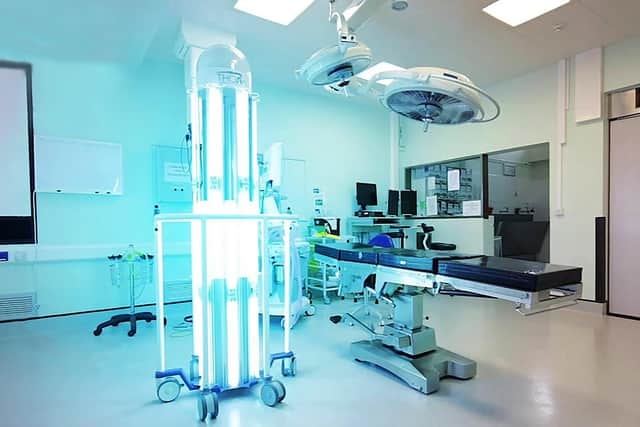Futuristic robot that has the ability to find and zap killer bugs ‘could save lives and billion of pounds’
and live on Freeview channel 276
An Ackworth woman claims a futuristic-looking robot could help save countless lives and billions of pounds for the NHS, with its ability to find and zap killer bugs such as Covid-19 and MRSA within minutes.
It may look like a character from Star Wars, but Charlie Taylor says ‘Thor’ - a radically-advanced machine that uses ultraviolet light to kill off germs in hospital rooms - is now being put to work in a growing number of hospitals across the world.
Advertisement
Hide AdAdvertisement
Hide AdManufactured by Finsen Technologies, the company has spent years researching and building the patented machine, and Mrs Taylor, who works as a distributor, is confident it can revolutionise hospital hygiene.


As a sales manager, she is quick to admit her work involves pitching to corporations, but she fears the general public is largely unaware that such machines exist, or what they are capable of.
The 45-year-old, who grew up in South Kirkby and attended Minsthorpe College, said: “Taking sales aspects aside, anyone can see how this would benefit hospitals.
“Patients are so frightened to go into hospital with everything that has happened in the last few months you would think the NHS would be all over this.
Advertisement
Hide AdAdvertisement
Hide Ad“From a patient perspective, it would give them more confidence to go into hospital. It’s about making people safe.


“Hospital-acquired infections are absolutely rife, no matter how much you think you can clean a theatre.
“This machine is so clever.
“You could send cleaners in but are they going to get every last thing using a mop and bucket?
“No, they are not.”
Taking years to devise, the machine costs £40,000 and uses military-grade equipment to ensure rooms are fully sanitised.
Advertisement
Hide AdAdvertisement
Hide AdAdjustable to above two-metres high, the machine can simply be wheeled into a room and plugged in.
Everyone must leave the room before it starts and if it detects anyone present it will shut down immediately.
It then automatically scans every last inch of the room from floor to ceiling, and every bit of furniture or equipment within it, locating every last organism of harmful bacteria before sending the data to a computer tablet.
It then delivers a calculated dose of ultraviolet C (UVC), which kills almost 100 per cent of all detected germs.
Advertisement
Hide AdAdvertisement
Hide AdCompleting the cleanse within 40 minutes, it is far quicker and more effective than standard hand cleaning.
Some hospital theatres can take more than two-and-a-half hours to complete a clean, with cleaners forced to wait for airborne germs to settle, thus putting a greater time strain on staff, operations and procedures.
However, Thor detects and kills all particles while they are still airborne.
In addition, it leaves detectable markers to log what it had found, killed and when it was cleaned, producing huge quantities of data to ensure areas remain sanitised.
Advertisement
Hide AdAdvertisement
Hide AdHospitals across the world are now using the machine, including one as far away as Sydney, Australia.
Data has shown that those using the machines have seen a 34 per cent drop in hospital-acquired infections.
Those infections are reported to cost the NHS £1 billion a year, but still the uptake of the technology in Britain’s hospitals has been slow.
None of the hospitals in Yorkshire yet have the machines, but Mrs Taylor says this is not down to an unwillingness, but more to do with red tape.
“With the NHS it’s a long process, she said.
“It’s so completely new, the challenge we are finding is who do we talk to about this.
“It’s new, but the evidence is there to support the claims about what it can do is phenomenal.”